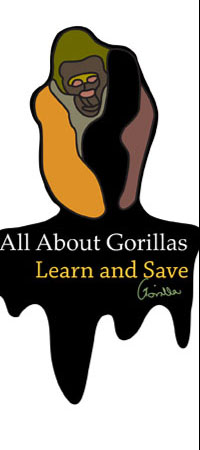|
Several million years ago the gorilla split from its closest living relative the chimpanzee. It is thought that originally gorilla were just one species, but changed as they spread and adapted to different living conditions.
As gorillas are ground dwelling they have evolved without a tail, which is used by other primates for balancing and gripping when climbing trees. They have good hearing, which is necessary in thick vegetation where visibility can be poor and good eyesight which they use to identify food.
Social Structure
Gorilla’s live in groups called a troop, which can be made up of 2- 40 animals. Within this group there is one dominant silverback male several females and younger males and offspring of different ages.
Silverbacks
Are large adult males with distinctive silver coloured hair on their back. This is developed through maturity and is usually present on male Gorilla’s over 12 years of age. An adult silverback can weigh over 180 kg and is the biggest and heaviest of all living primates. As the leader of the group the dominant silverback is in charge of protecting its troop from predators or rival silverbacks, displaying a broad chest and large canine teeth when threatened. The dominant silverback is also in charge of finding good places to forage for food and safe places to rest and sleep. If the dominant silverback dies then a troop will disband and form new groups.
Blackbacks
Younger male gorillas are called blackbacks because they have not yet developed silver hair on their back like mature males, though all males will not necessarily develop a silver back. They support the leader and help them forage. When they reach sexual maturity at the age of ten they leave their family groups to join another or form their own and find a mate. They usually travel alone or with a group of other males until they can attract a mate.
Females
Females leave their family groups when they reach sexual maturity in order to prevent in breeding. They can join lone male or other females and within groups are ranked according to when they joined the group; this rank is passed on to their offspring. They form strong relationships with males through behaviour such as grooming, which is important as male gorillas provide protection from predators.
Juveniles and Infants
Young infants are playful and inquisitive, and for the first 3-4 years of their lives they have close bond with their mother. Juveniles will groom each other and the dominant silverback will groom juveniles and protects them.
Relationships
Gorillas are social animals and within troops exist different relationships. All females in the troop have a strong relationship with the dominant silverback, which is strengthened through bonding activities such as grooming. However males and females are often aggressive to each other, though it rarely results in death.
Female to female relationships are not strong and often aggressive fighting occurs over access to males. Relationships between males are not strong because of dominance issues however within all male groups individuals are friendlier with each other.
Gorillas are tolerant of other species and would only attack if they felt threatened. They are wary of humans and it takes a long time to build their trust.
Daily activities
Gorillas walk around 1 km each day at a slow pace foraging for food. They wake up early between 6-8 am and spend the day eating and playing and relaxing. Each evening between 5-6 pm they build a bowl shaped nest from leaves and vegetation to sleep in, which keeps them warm and only a mother and her offspring share a nest.
|









